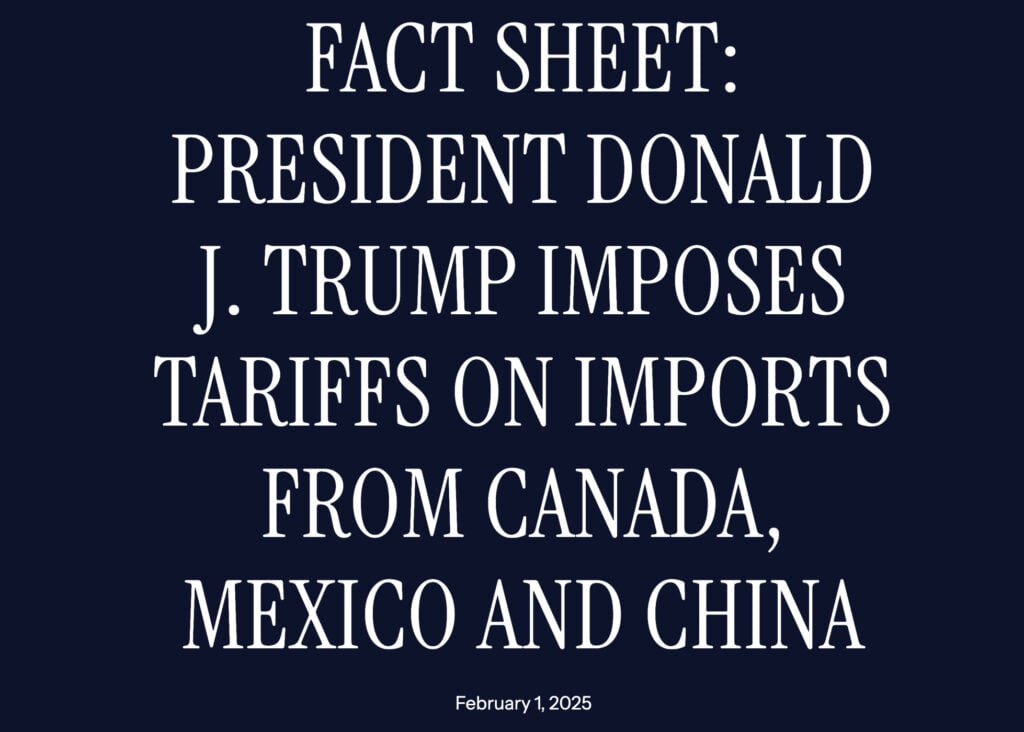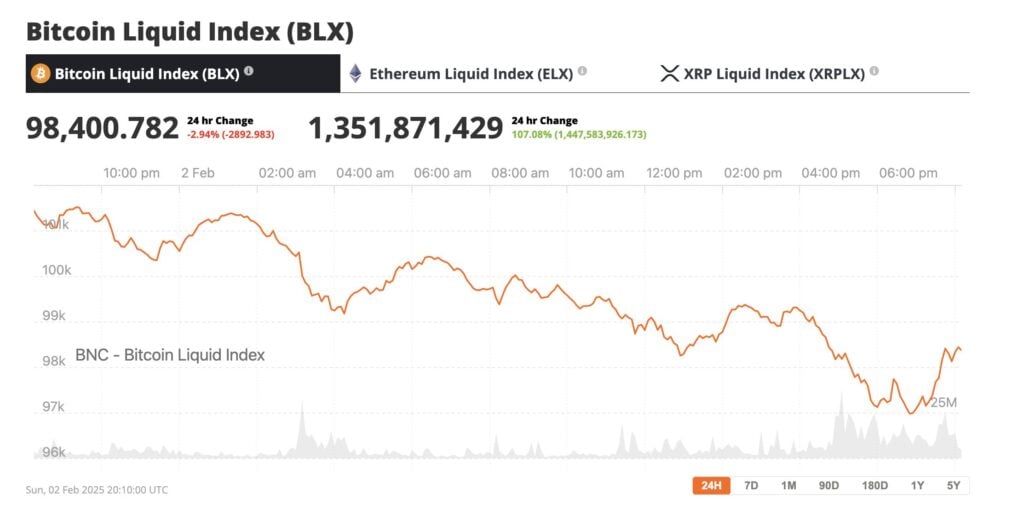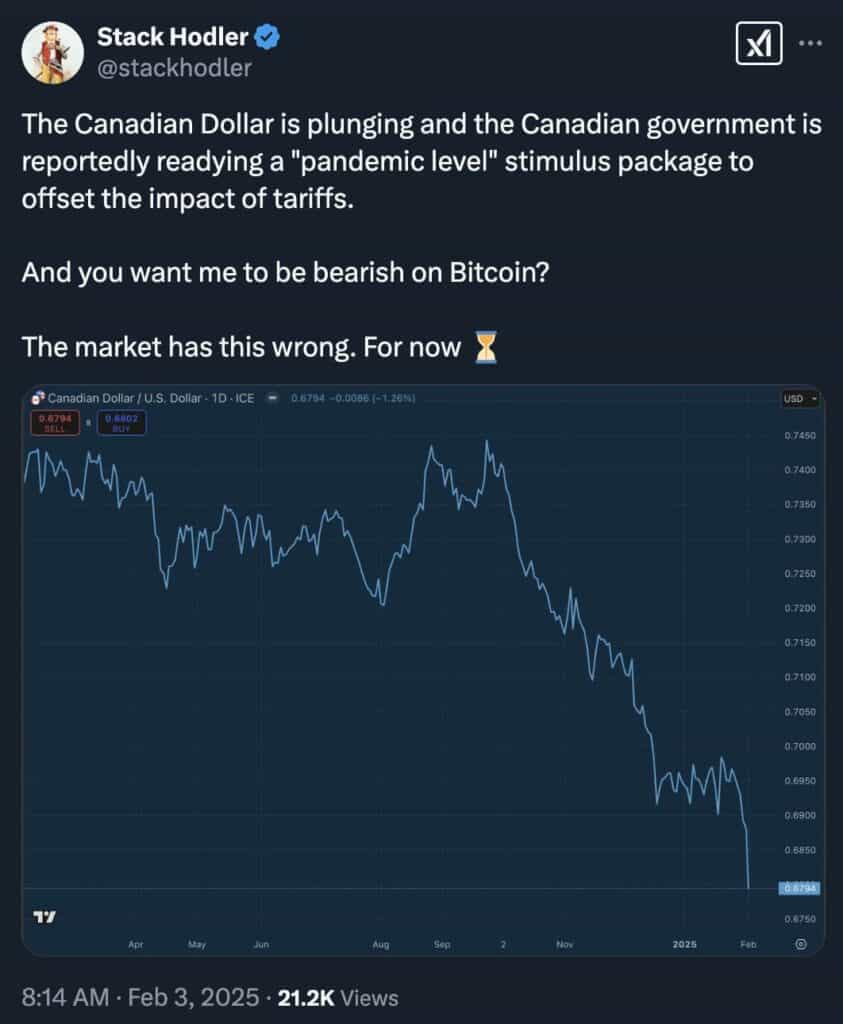On February 1, 2025, President Donald J. Trump announced the imposition of new tariffs aimed at addressing national security concerns related to illegal immigration and the influx of illicit drugs, particularly fentanyl. The measures include a 25% tariff on imports from Canada and Mexico, with a reduced 10% tariff specifically on Canadian energy resources. Imports from China will face a 10% tariff.

Trump Tariffs target China, Canada and Mexico, source: White House
The administration justifies these tariffs by citing the failure of Mexico, Canada, and China to fulfill their commitments to halt illegal immigration and prevent the flow of dangerous drugs into the United States. The orders highlight the role of Chinese officials in not adequately controlling the export of precursor chemicals used in drug manufacturing and accuse Mexican drug trafficking organizations of having an “intolerable alliance” with the Mexican government, facilitating the production and transport of narcotics. Additionally, there is concern over the increasing presence of Mexican cartels operating drug synthesis labs in Canada.
These actions are taken under the authority of the International Emergency Economic Powers Act (IEEPA), declaring the situation a national emergency. The administration emphasizes that access to the American market is a privilege and that tariffs are a powerful tool to protect national interests. The statement criticizes previous administrations for not leveraging America’s economic position to secure borders and combat drug trafficking effectively.
In response, both Canada and Mexico have announced plans to implement retaliatory tariffs on U.S. goods, signaling the onset of a trade conflict among the neighboring countries. An early sign of things to come is the fall of the Canadian dollar against the USD.
The End of American Hegemony: A Shift Towards a Multipolar World
The United States is undergoing a seismic shift in its global strategy, signaling the end of its era as the indispensable nation and embracing a new multipolar world order. This transition is marked by:
- Dismantling its foreign influence apparatus, including institutions like USAID.
- Marco Rubio openly acknowledging that the U.S. is no longer the sole global power, stating that the post-WWII global order is now obsolete and being used against American interests.
- Imposing tariffs on allies like Mexico, Canada, and the EU, redefining alliances from a vassal-client model to interest-based negotiations.
A Controlled Retreat, Not a Collapse
While this shift appears chaotic—especially to those who still believe in American primacy—it is likely a strategic choice rather than a forced retreat. The U.S. was always going to lose its global dominance eventually; instead of waiting for an inevitable collapse, it’s choosing to step back on its own terms.
This doesn’t mean America is withdrawing from the world—it may, in fact, become even more aggressive. The difference is that it no longer has to maintain the illusion of a “rules-based order” or play nice with allies. Without the burden of global stewardship, American foreign policy could become even more transactional and disruptive.
Perhaps the biggest losers in this shift are America’s traditional allies, who are now caught off guard as the U.S. stops treating them as protected partners and starts negotiating with them as equals. This marks one of the most significant transformations in global politics since the fall of the Soviet Union.
Why Trump’s Tariffs Are Good for the U.S. Economy
For years, Chinese fast-fashion giants like Temu, SHEIN, and AliExpress have enjoyed an unfair trade advantage, flooding the U.S. market with cheap, often low-quality products while dodging import duties that American companies are required to pay.
The reason? A glaring loophole in U.S. trade law known as the “de minimis” rule—a decades-old regulation that allows any package valued under $800 to enter the country duty-free, tax-free, and largely uninspected. This rule, originally designed for small personal imports in an era before global e-commerce, has been ruthlessly exploited by Chinese companies to ship billions of dollars’ worth of goods directly to American consumers without any oversight.
The numbers are staggering:
- In 2023, over 1 billion packages from China entered the U.S. under this loophole.
- Temu, SHEIN, and other direct-from-China platforms paid $0 in import duties, while American retailers like GAP and H&M paid hundreds of millions.
- U.S. Customs and Border Protection (CBP) is overwhelmed, unable to properly inspect shipments, allowing counterfeit goods, products made with forced labor, and even chemicals used in fentanyl production to slip through.
This isn’t “free trade.” This is a backdoor for subsidized foreign competition to undermine U.S. businesses.
How It Works—and Why It’s Been So Abused
Chinese sellers have gamed the system in two major ways:
- Breaking up large shipments into thousands of individual packages to stay under the $800 threshold.
- Using U.S.-based logistics partners to receive bulk shipments, then split them up and re-mail them as de minimis parcels, further evading duties and inspections.
This scheme has allowed China to bypass tariffs, avoid scrutiny, and dump artificially cheap goods into the U.S. market, undercutting domestic businesses that actually have to pay taxes, follow regulations, and comply with labor laws.
It’s also been a national security risk: Shipments entering through the de minimis loophole have been identified as a key channel for smuggling fentanyl precursors into the U.S. By skipping standard customs entry, these shipments largely avoid detection, making enforcement nearly impossible.
The Loophole Is Finally Closing
On Tuesday, De minimus entries from China will be shut down for good. With the new Trump tariffs shutting down this exploit for Chinese goods, the impact will be massive:
✅ U.S. retailers will no longer face unfair competition from companies that evade duties and flood the market with ultra-cheap, low-quality products.
✅ More products will have to go through proper customs inspections, making it harder for counterfeit goods, forced labor products, and illicit substances to slip through.
✅ China’s vertically subsidized logistics and manufacturing dominance takes a hit, leveling the playing field for U.S. manufacturers who have long struggled to compete against artificially low prices.
This is one of the biggest victories for American businesses and trade fairness in years.
For too long, Chinese exporters and complicit U.S. importers have found ways to bypass U.S. trade rules—not just through the de minimis rule, but through a range of shady tactics including export sanction violations, customs fraud, and foreign trade zone abuse. The new tariffs are finally putting an end to these backdoor schemes.
There have been big holes in global logistics leading to weaker American economic security and domestic industry. This is a long-overdue correction to a broken system by a brave new President prepared to take some short term pain for long term gain.
Why Bitcoin Is the One Trade to Rule Them All
Jeff Park, Head of Alpha Strategies at Bitwise wrote on X that Bitcoin is his highest conviction macro trade for the year. Park says Plaza Accord 2.0 is coming and the financial war will send Bitcoin violently higher.
Park says that to truly grasp tariffs in today’s world, you need to frame the conversation in two key contexts: 1) the ongoing curse of the Triffin dilemma, and 2) Trump’s personal financial incentives. Once you analyze both, the inevitable conclusion becomes clear: tariffs may be a temporary mechanism, but the permanent outcome is this—Bitcoin isn’t just going up, it’s accelerating.
The Triffin Dilemma and Tariffs
First, the Triffin dilemma: As the global reserve currency, the U.S. dollar enjoys what’s known as “exorbitant privilege”, but this comes with unavoidable trade-offs:
The dollar is artificially overvalued because global reserves must hold it in a price-inelastic manner.
The U.S. must run chronic trade deficits to supply the world with those dollars.
The U.S. government enjoys cheap borrowing that it otherwise wouldn’t have access to.
The U.S. wants to keep cheap borrowing (#3) while somehow escaping the constraints of an overvalued dollar (#1) and persistent trade deficits (#2). The solution? Tariffs.
Tariffs are not just protectionism—they’re leverage in global financial warfare. They serve as a short-term negotiating weapon to push for a broader, coordinated realignment: a modern Plaza Accord. The goal? Force nations to offload dollar reserves and extend their U.S. Treasury holdings further out on the curve. In other words, Trump is maneuvering to pull off a “YCC, not YCC” play—a de facto form of yield curve control without needing the Fed’s formal intervention.
And this is where Scott Bessent comes in. He understands that Yellen has left behind a fiscal disaster, doubling the proportion of debt financing via T-bills—injecting fake liquidity into the system while leaving the U.S. at the mercy of short-term refinancing just as rates were spiking. The end result? A catastrophic mismanagement of duration risk that will cost U.S. taxpayers dearly.
Thus, the real endgame is the holy grail of fiat: a weaker dollar and lower yields—a near-impossible feat that tariffs are meant to help engineer.
Trump’s Personal Play: Real Estate and the 10-Year Yield
Now, the second pillar: Trump’s motivations. His #1 priority is to drive down the 10-year yield because his own empire depends on it—real estate.
His initial obsession with Powell cutting short-term rates proved ineffective, leading him to a new strategy. Trump is bluntly profit-driven—which makes his actions predictable. Never underestimate the power of a self-interested billionaire with direct policy influence. One way or another, the 10-year yield is coming down.
The Asset to Own: Bitcoin
This is why Park says that Bitcoin is the trade of the decade. In a world where the dollar weakens and U.S. yields drop—something mainstream analysts will tell you is impossible because they fundamentally misunderstand statecraft—risk assets in the U.S. will go parabolic.
But here’s the kicker: the cost of tariffs—most likely through inflation—will be borne by both the U.S. and its trading partners. However, the relative impact will cripple foreign economies more. These countries will be forced to counteract economic slowdowns with aggressive monetary and fiscal stimulus, ultimately devaluing their own currencies.
Citizens in these nations—suffering from depreciating fiat and potential financial crises—will turn to alternatives. And unlike the 1970s, when there was no digital escape hatch, today Bitcoin exists.
So, while both sides of the trade war will seek Bitcoin for different reasons, the outcome is the same: higher prices, violently faster—because this is financial warfare.

Bitcoin dumped under $100,000 but could recover if Park’s thesis plays out, source: Bitcoin Liquid Index
As Stockholder wrote on X, The Canadian Dollar is plunging and the Canadian government is reportedly readying a “pandemic level” stimulus package to offset the impact of tariffs. And you want me to be bearish on Bitcoin? The market has this wrong. For now.

This could be a hugely bullish set up for Bitcoin, as Stockholder wrote on X.




